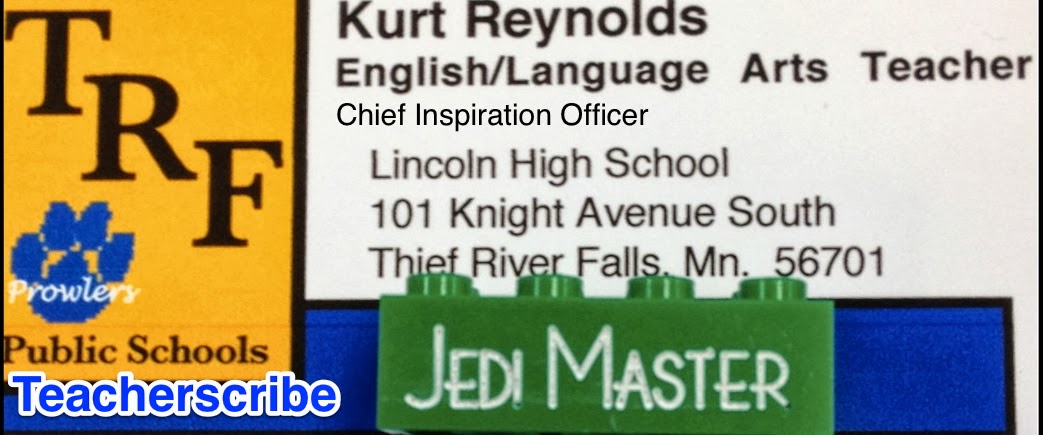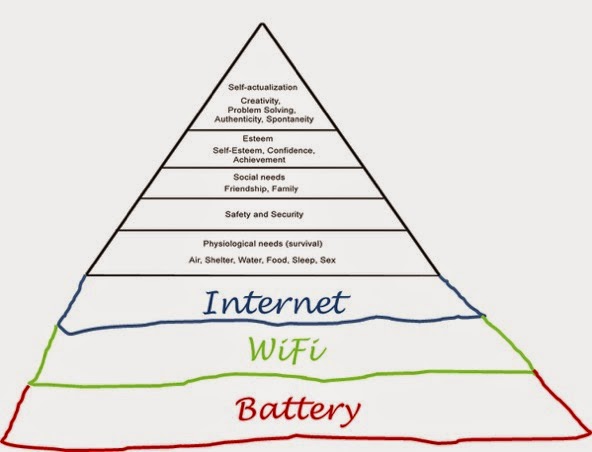I always start the semester strong. I'm trying new things and re-energized by the old things - the staples of my curriculum. However, somewhere before the end of the semester, the doubts set it.
As my expectations for my students rise, I begin to feel like they are neither achieving enough nor learning enough. I feel like a fraud, like a cheat.
This usually lasts for a week or two.
Then with about two weeks left in the semester, thing change, thankfully. The final projects and papers come in, and I realize, thankfully, that my students have achieved some things and learned a thing or two. It's never enough, but it is enough to make me reconsider feeling like a fraud.
Thankfully, on the last day of each semester, I get a rush - despite being sad at seeing my students go - that I know I can do it better the next time.
And the circle continues . . .
I found this on Twitter. Bloom's Digital Taxonomy. I need to print this out and keep it on my desk as a constant reminder.
I love the verbs used in the "Activities with Digital Tools" -
mashing, reverse engineering, publishing, blogging, programming, podcasting, refactoring, commenting . . . I can never do enough of that in my classes.
*****
Makerspace
This was a term I discovered at this year's TIES conference.
I had never heard of it before, but I was blown away with what I learned. And what I learned was just the tip of the iceberg.
Makerspace? You ask. I know.
That was my initial reaction too.
Here is a definition -
What is it?
A makerspace is a physical location where people gather to share resources and knowledge, work on proj-ects, network, and build. Makerspaces provide tools and space in a community environment—a library, community center, private organization, or campus. Expert advisors may be availablesome of the time, but often novices get help from other users.The makerspace—sometimes referred to as a hackerspace—is often associated with fields such as engineering, computer science, and graphic design. The concept emerges from the technology-driven “maker culture,” associated with Make magazine and the Maker Faires it promotes. This idea of a collaborative studio space for creative endeavors has caught hold in education, where the informal combination of lab, shop, and conferenceroom form a compelling argument for learning through hands-on exploration. On campus, the makerspace is being embraced by the arts as well as the sciences, and a new energy is buildingaround multidisciplinary collaborative efforts.
A makerspace is a physical location where people gather to share resources and knowledge, work on proj-ects, network, and build. Makerspaces provide tools and space in a community environment—a library, community center, private organization, or campus. Expert advisors may be availablesome of the time, but often novices get help from other users.The makerspace—sometimes referred to as a hackerspace—is often associated with fields such as engineering, computer science, and graphic design. The concept emerges from the technology-driven “maker culture,” associated with Make magazine and the Maker Faires it promotes. This idea of a collaborative studio space for creative endeavors has caught hold in education, where the informal combination of lab, shop, and conferenceroom form a compelling argument for learning through hands-on exploration. On campus, the makerspace is being embraced by the arts as well as the sciences, and a new energy is buildingaround multidisciplinary collaborative efforts.
What could my students accomplish if I gave them the opportunity to do this more?
What I love about this concept is that it gets kids out of their traditional "school" routine of sitting quietly and working in their own little silos. In a makerspace environment, students can bring in their own resources to not only use but to also share, they can get constant feedback from their peers, and - best of all - the teacher can be a supportive, guide on the side.
Here is an example of how it worked in one - middle school (I'm guessing) English classroom.
*****
Here is a 21st century version of Maslow's Hierarchy of Needs. Oh my, how this differs from what my life was like as a high school student.
I can't help but wonder what will be added by the time my Kenzie and Cash are in high school!
I love this because it is absolutely true. Don't believe me? Just watch the frustration that ensues when the wifi/internet goes down. And want to talk about dire straits? Just imagine your phone dying or your laptop going dead.
That is why I love this -
If someone asked me to describe what 21st education looks like, I'd show them this picture. It's messy. Kids are plugged in. There is uniformity (look at all of those iPhones), yet there is a strong desire for individuality and differentiation (just look at all the unique covers . . . not to mention what the screen savers and backgrounds would all look like if we could see them). Overall, there is a need to recharge and to be connected. How do we do all of that in our classrooms?
Better yet, how do we get students to concentrate in such an environment. How do we get them to unplug? More importantly, how do WE get unplug? How do we get them to distance themselves (and ourselves) from all the digital distractions to put in the hard work, what Cal Newport refers to as deliberate practice as part of the craftsman's mindset, in order to master skills?
This info graph shows us just some of the distractions we all face.
It's vital to show students all that they can connect to and accomplish. I love what Thomas Friedman says in The World is Flat: If it's not happening, it's because you're not doing it. In other words, our students today in the span of a couple clicks, can accomplish what it would have taken me a month to do 20 years ago.
However, I think it's just as vital to show students how to unplug and work with their hands and get dirty and do it old school.
*****
The Key to Success? It's one word: Grit.
*****
Here is an interesting read on a new biography of my all-time favorite poet: ee cummings.
******
This photo essay lives up to its title: 15 Photographs That Will Open Your Eyes to the Wonders of the World.
******
For those who are struggling with student cell phone use, here is an interesting solution: 3 Ways to Teach Cell Phone Etiquette.
First, teachers need to model appropriate behavior. If we don't want kids on their phones, we can't be on ours. Sounds simple, right? Yet, I'm amazed at how many of us (me included certainly) are on our phones.
Second, outline the rules. And this is where I'm not as effective as I can be. If students are to have them put away, hold them to that. Don't let up because there are five minutes left in class. Likewise, if students can use them - as in my class - I need to have rigid rules in place: phones have to be away when we are discussing something and when another student is talking.
Third, use real world-consequences. I like the consequence the offer here - if a student uses their phone while someone else is talking, stop the class, remind the student to put her phone away, THEN have that student issue an apology to the entire class. You could even have them Tweet it too!
*****
Now this is really, really interesting.
For a long time, we have debated what is best for students: to cover just a few things in great depth or to give them a survey of many different things. It's the old an inch wide and a mile deep vs. a mile wide and an inch deep dilemma.
This approach definitely takes the former approach -
The program is called Agency By Design and it relies on nimble, malleable activities Project Zero researchers call “thinking routines” that slow down the pace of the classroom to make space for deep observation and wonderment.
Now this article and assignment focuses more on design (such as looking at how well a pencil is designed to accomplish its main purpose). But is it that great of a stretch to apply this to other areas of learning?
“The main focus we’re looking at is an idea about how students might gain an alertness to their designed world, the designed objects and systems in their world,” said Jessica Ross, a senior practitioner specialist at Project Zero. “If you have multiple opportunities to engage with the designed world and notice the complexities of the design, will those repeated activities allow you to see that you might change that design?”
In a working world where students have to be life long learners and critical thinkers, how can this approach be bad?
I could easily see this approach - outlined below - could be applied to English, such as the elements of plot or rhetoric -
One big emphasis in the project so far has been on looking deeply at even the simplest of objects. In a thinking routine called “parts, purpose, complexity” students are asked to carefully observe the individual parts that make up an object. When each part has been thoroughly explored they start discussing and wondering about the purpose of each part. Then they think about how even a simple object can be complicated when broken down into its component parts.
The ultimate goal is this -
“I’m moving them in a direction to question things around them and be really curious about the world around them,” Aiello said. She sees the routines building critical thinking skills and reigniting wonder in her students, something she hardly saw before, even in kindergarteners. The open-ended quality to wondering, and lack of a right or wrong answer, has also inspired her students to start wondering about more the stories they read in class. That was a new experience for many of them, who don’t often read at home and aren’t accustomed to questioning stories they’re told.
This reminds me of this TED Talk I came across with the excellent title: The Future Will Not Be Multiple Choice.
This teacher does the same "see, think, wonder" exercise, not with pencils but with a Kleenex box. And it goes over like gangbusters.
To question and be really curious. What can't students learn with those to traits? Sure beats the hell out of anything the common core wants us to get our students to master right now.
To drive the power of innovation home, here is a great short talk by Sir Ken Robinson on building a culture of innovation.
*****
This is so true, it's scary. In fact, I think that phrase should never be uttered again. I love the approach the CEO of Dillano's Coffee House takes. David Morris's mantra is the opposite of "If it ain't broke don't fix it. They always seek to break what works well." In other words, they shoot their golden calves. There is ALWAYS a way to improve.
****
This is a very candid article on bullying from a mom's point of view, who was a bully herself.
I think we teach our kids the most when we don't lie to them or act hypocritically ("Do as I say, not as I do"), but when we are honest with them. I applaud this mother for doing just that.
****
And finally, because science is so cool, here is a great brief glimpse at where life may (already) reside in our solar system.






No comments:
Post a Comment